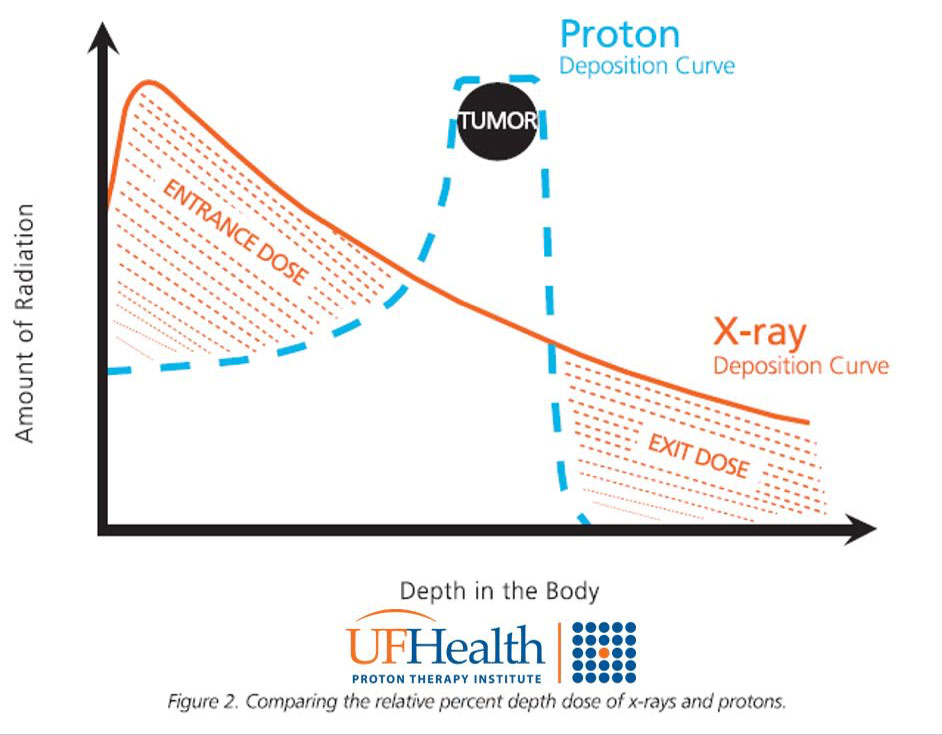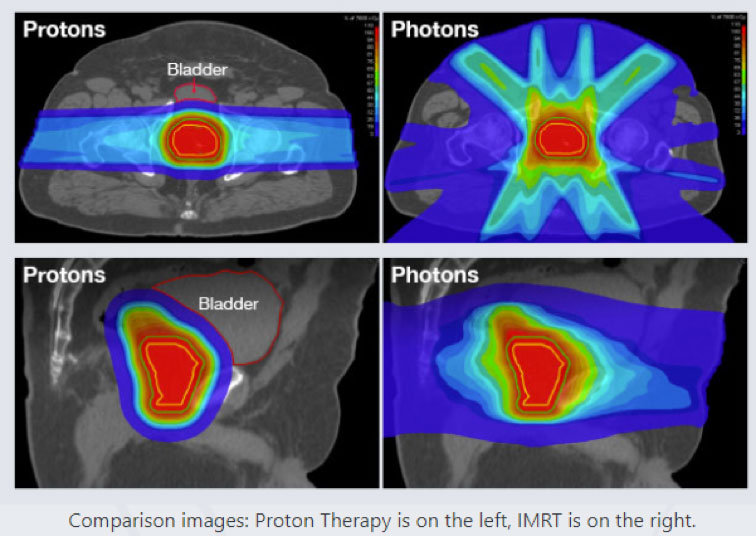Radiation treatment for prostate cancer
By Bradlee Robbert and Christina L. Mershell
Share:

Have You Been Diagnosed with Prostate Cancer?
Being diagnosed with prostate cancer can be overwhelming, especially when considering treatment options. Although surgery is often recommended, exploring alternative treatments, such as radiation therapy, is essential. This article delves into the benefits of external beam radiation therapy, focusing on proton radiation therapy as a viable, non-invasive option for prostate cancer treatment. It’s best to review multiple resources, such as the American Cancer Society, for other prostate cancer treatment options.
Types of Radiation Treatments for Prostate Cancer:
Several radiation treatment options exist for men diagnosed with prostate cancer. Here are some noteworthy choices:
X-ray or Photon Radiation:
This traditional method of delivering radiation to cancer is available in most communities. X-ray or photon radiation is a method of external beam radiation therapy (EBRT) where the X-rays enter the body at a high dose of radiation, damage the tumor cells and continue to deliver radiation as they exit the body.
To reduce radiation doses to normal tissue, photon therapy has multiple delivery techniques, such as Intensity Modulated Radiation Therapy (IMRT), Volumetric Modulated Arc Therapy (VMAT) and Stereotactic Body Radiation Therapy (SBRT), each of which have different benefits for a patient. Finding the right photon-based treatment requires a thorough discussion with a radiation oncologist.
Proton Radiation:
Proton therapy, another form of external beam radiation therapy, is delivered using proton particles. The physical properties of a proton particle allow for lower doses of radiation deposited in healthy cells in front of the tumor and no radiation delivered behind the tumor, minimizing damage to surrounding healthy tissue.
Proton therapy is delivered in two primary methods: double scattering or pencil beam scanning (PBS). Double scattering proton therapy requires two sets of custom-blocking devices to shape the beam to the target, while pencil beam scanning utilizes magnets to steer the beam.

Brachytherapy:
Brachytherapy is a type of internal radiation therapy in which seeds, ribbons or capsules containing a radiation source are placed near or in the tumor, releasing radiation gradually over several months.1 While effective, this treatment may limit social interactions during the treatment period due to radiation precautions.
What is External Beam Radiation Therapy?
External beam radiation therapy uses high-energy X-rays or particles, like protons, to target and eliminate cancer cells without invasive procedures. Radiation oncologists administer this form of treatment, and it has gained recognition for its effectiveness in managing various cancers, including prostate cancer.
Why is External Beam Radiation Therapy a Good Choice for Prostate Cancer Treatment?
External beam radiation therapy is a non-invasive treatment alternative to surgery, allowing patients to combat cancer without undergoing a prostatectomy. While there are limitations to radiation therapy in some cases and potential damage to some healthy cells, the expertise of well-trained radiation oncologists, coupled with advanced treatment techniques, minimizes side effects commonly associated with surgery.
The benefits of radiation treatment for prostate cancer is the ability to minimize the side effects of a prostatectomy, which often include urinary incontinence, bleeding and erectile dysfunction due to damage to the bladder, urethra and surrounding nerves and blood vessels.
Radiation therapy is a viable choice for the treatment of prostate cancer when surgery is not an option or a less invasive treatment option is preferred.
Benefits of Proton Radiation Therapy for Prostate Cancer:
External beam radiation therapy utilizing photons or protons are viable treatment options for patients battling prostate cancer. Often, patients with prostate cancer seek out treatments that have the fewest number of side effects. Due to the physical property of a proton, and the ability of the radiation to be stopped at the prostate, proton therapy offers the ability to deliver high, curative doses of radiation to the cancer cells while minimizing radiation exposure to normal tissues. This is most evident when comparing radiation doses to the bladder and rectum. In the image below, the curative dose of radiation is red. Notice that both treatment modalities provide equivalent radiation to the prescribed treatment area. However, proton therapy greatly reduces the total dose of radiation to the pelvis, including the bladder and rectum.

With less radiation damaging healthy tissue surrounding the prostate, men often see fewer side effects including:
- Low rates of urinary incontinence
- Less urinary frequency
- Less urination at night
- Less erectile dysfunction
- Less impotence (inability to get and maintain an erection)
What are the Side Effects of Proton Therapy for Prostate Cancer?
It is important to understand that prostate cancer treatments may have side effects. Each treatment option carries risk of acute side effects (those that happen during or immediately after treatment) or latent side effects (long-term complications). Even though proton therapy reduces side effects, patients can expect to experience the following during treatment:
- Fatigue
- Urinary frequency
- Urinary burning
Click here for more info on the side effects of radiation treatment.
What are the Outcomes of Proton Therapy? Is Proton Therapy Effective?
Based on a 2016 study of more than 1,300 men treated with image-guided proton therapy for prostate cancer that had not spread, proton therapy provided excellent outcomes (in terms of survival) five years after treatment. In addition, there were low rates of severe side effects, leading to high quality of life per outcomes reported by patients themselves.2
Comparing Outcomes of Proton Therapy Radiation and Traditional X-ray Radiation:
Five Years After Treatment
|
Patient Risk Category at Diagnosis |
Percent (%) of Patients Cancer-Free at Five Years After Proton Therapy (IMPT) 2 |
Percent (%) of Patients Cancer Free at Seven Years After Traditional X-Ray Radiation Therapy (IMRT) 3 |
|---|---|---|
|
Low-Risk Prostate Cancer |
99% cancer-free |
98% cancer-free |
|
Intermediate-Risk Prostate Cancer |
94% cancer-free |
86% cancer-free |
|
High-Risk Prostate Cancer |
74% cancer-free |
68% cancer-free |
Does Proton Radiation Cause Urinary and Bowel Side Effects?
One compelling study compared the effectiveness of proton therapy versus traditional X-ray radiation for prostate cancer, based on the side effects that patients reported to their doctors. Men treated with proton therapy reported having 50% fewer issues with bowel urgency and bowel frequency.4
In addition, per a study by Pugh et al,5 patients reported that they had minimal bowel and urinary side effects, which returned to the same level as they were before treatment (or even improved in most patients) within two years after treatment.
Patient Quality of Life After Proton Therapy for Prostate Cancer:
Will Radiation Therapy Impact my Sexual Function?
The short answer: it’s possible, and likely. There are many factors that affect erectile function, such as age and general health, but treatment for prostate cancer is likely going to have a negative impact on sexual function, a man’s ability to obtain an erection sustainable for intercourse. The vast majority of studies, such as the "Patient-reported outcomes after monitoring, surgery, radiotherapy for prostate cancer"6 demonstrate that surgery has a larger impact on sexual function than radiation therapy. However, there is promising news for men concerned with erectile dysfunction. Proton therapy was shown to have a minimal impact to erectile function for men younger than 60 years old. The study also demonstrated that the healthier the man, the less impact there was on erectile function.6
The ProtecT trial showed that only approximately 20% of men who had a prostatectomy were potent 5 years after surgery, while approximately 35% of men who chose not to have any treatment were potent 5 years after surgery (see graph below).7

(Image from publication referenced above8 https://www.nejm.org/doi/full/10.1056/NEJMoa1606221)
Patient Story: Arthur Bendolph's Experience
After seeing a urologist, having an MRI and seeing a few other specialists, Arthur wasn’t comfortable with the potential or possible side effects from conventional cancer treatment options. Arthur kept doing his research and soon discovered the Institute. He couldn’t believe that this place (“the best in the world,” as he said) was right in his backyard. He did more research, couldn’t find a downside to proton therapy and scheduled an initial consultation at the Institute.
Arthur feels lucky that he didn’t need surgery or chemotherapy. The proton therapy treatment went well, and he only felt some mild fatigue. Following treatments, he says it took him just a couple of weeks to feel like his old self again. Read more about Arthur’s story.
Conclusion:
Benefits of Radiation Therapy
- Non-Invasive
- Reduced side effects
Benefits of Proton Radiation Therapy
Proton therapy takes radiation treatment to another level, offering men the option of a non-invasive treatment for prostate cancer. With its ability to target cancer cells effectively while minimizing damage to healthy tissue, proton therapy offers improved quality of life for patients, reducing the risk of urinary and bowel side effects. By understanding proton therapy's advantages and potential outcomes, individuals diagnosed with prostate cancer can make informed decisions about their treatment journey.
There are many high-quality studies that demonstrate the utility of proton beam therapy for prostate cancer. For example, Dr. Curtis Bryant, UF Health Proton Therapy Institute radiation oncologist, published "Consensus on proton therapy for prostate cancer"8 in 2021 that has a comprehensive review of proton therapy as a viable treatment option for prostate cancer. Another valuable resource is the International Journal of Particle Therapy, which has open access publications about proton therapy from centers actively treating patients. Before deciding on your cancer treatment options, do your own research and ask questions. For prostate cancer patients, there are many viable treatment options. Ultimately, your treatment is your choice.
Disclaimer:
The views and research published in this blog are general views only. Patients must make informed patient-specific decisions with their doctors. Results with any cancer treatment vary based on many factors, such as age, cancer stage, health and other factors.
Reviewed Sept. 18, 2023, by Curtis Bryant, MD, MPH
1 https://www.cancer.gov/about-cancer/treatment/types/radiation-therapy/brachytherapy
2 https://pubmed.ncbi.nlm.nih.gov/27084658/
3 https://www.ncbi.nlm.nih.gov/pmc/articles/PMC5705018/
4 https://pubmed.ncbi.nlm.nih.gov/24139077/
5 https://doi.org/10.1016/j.ijrobp.2013.06.909
6 https://www.nejm.org/doi/full/10.1056/NEJMoa1606221
7 https://acsjournals.onlinelibrary.wiley.com/doi/10.1002/cncr.27398


